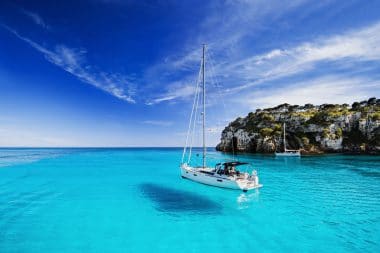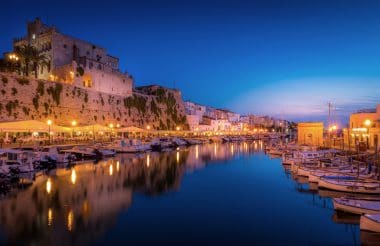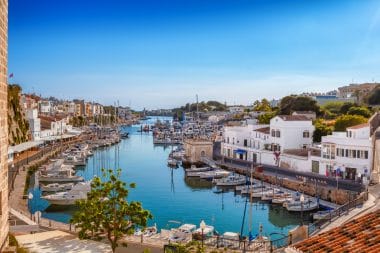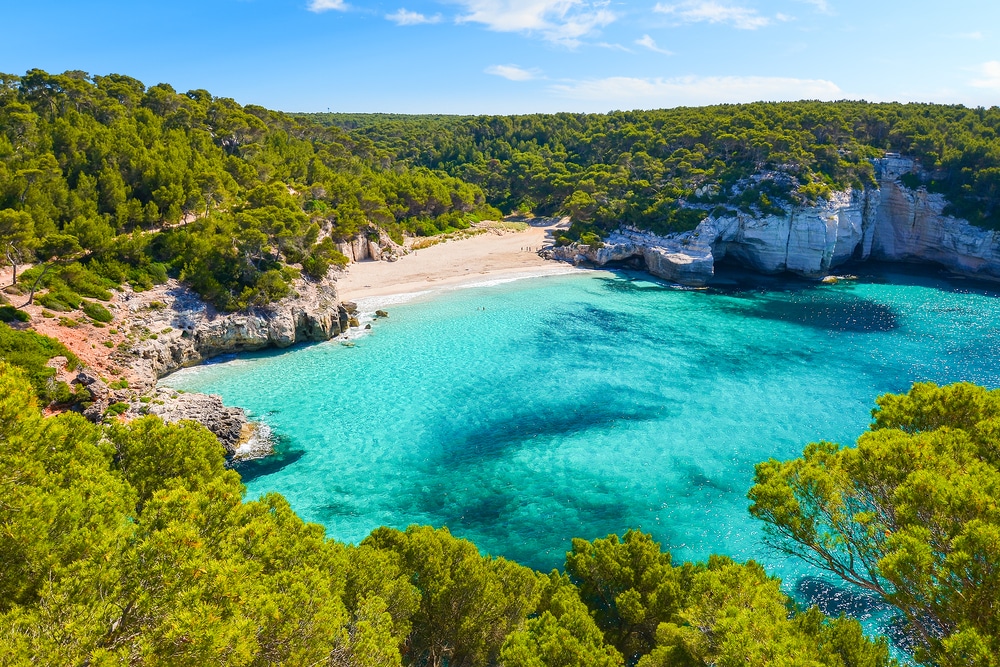“Menorca resembles a huge broad bean in its outline” – the island geographer Paul Falot once jokingly remarked. We now have a picture of an island that appears with fundamentally different sides. Fjords that mill deep into the interior characterize the north. Rugged rocks plunge dramatically into the sea. Its high steep slopes defy the waves on the 220-kilometre-long coast.
The bizarre rock formations surround a series of natural harbors. However, large parts of the coast offer themselves as undeveloped natural areas. In addition to mysterious buildings of the indigenous people, sleepy settlements grow along the south coast. In the interior you will find many small towns far away from the sea.
At first, the Balearic island seems a little monotonous – almost like a fortress made of stone: dark slate, stony fields, a flat landscape without any particular heights and prickly vegetation. The first impression is deceptive. During a foray the island reveals all its beauty. Past magnificent carpets of flowers, along fragrant pine and holm oak forests, to sparkling clean farms – it soon becomes clear: Menorca is one of the most magical spots in the Mediterranean. Only 45 kilometres separate it from its somewhat cheeky sister island of Mallorca. Menorca stands out as the lovely silence.
Bengvinguts – we discover Menorca!

Pitch-black horses and reddish-brown cows graze on lush green meadows. A feast for the eyes are the archaic-looking garden gates made of the wood of wild olive trees – bizarrely shaped by the wind. On the coasts, enchanted bathing spots are revealed. The center of the island attracts with probably the best lobster stew in the region. Gods and mythical creatures once ruled the windswept north coast and created captivating locations. On the other hand, vegetable gardens and orchids set colourful accents in the damp valley bottoms. Flower-covered snow-white holiday homes invite you to linger.
Maó appears as the dutiful and correct capital in the east, Ciutadella as the cheerful city in the west. For centuries, a competition has been smoldering between the two metropolises. The trigger was the English, who once occupied the island and made Maó the island’s capital in the course of some trade disputes. There are serious differences in the view of life as well as in the architecture. The real Ciutadella is reluctant to go to Maó. He only does this when he goes to the authorities. On the other hand, the capital’s eyebrow twitches when he takes on the notes of the western province.
However, travelers are magically drawn to both cities.
Discover the island in one day
Maó and the eastern tip – small towns and lots of untouched nature
The lively, official capital Maó should be dedicated to at least one day’s holiday. With an impressive natural harbour on the elongated harbour fjord and with the mighty fortress of Isabel II, the lively city, which is enthroned high up on the cliffs, inspires. On a tour of the harbour, visitors immerse themselves in colonial flair.
In the neighbouring town of Es Castell, the idyllic bay of Cales Fonts inspires with former boat and fishing caves, in which quaint pubs have nested. The waterfront promenade of Es Castell is lined with great restaurants. Not far away is the legendary bar Es Cau.
The fortress of Sant Felip and Fort Marlborough are particularly worth seeing.

Just a few kilometres to the north is the dreamy town of Es Grau with its many old houses. At the same time, the town is the gateway to the “Albufera des Grau Nature Park” with its wetland. The Albufera Lagoon is the heart of the protected area. The largest lagoon in Menorca reaches a depth of up to 3 meters.
To the south, Sant Lluis is the perfect starting point for a fantastic coastal trip with a view of the white villages.
Cala en Porter is worth mentioning for the cave of Xoroi, which is definitely worth a visit. From the large cave there is a wonderful view of the open sea. The east side of the bay developed more and more into a tourist settlement and has lost much of its charm since then.
Close by are the prehistoric burial caves of Cales Coves. A very special destination for island explorers.
If you want to connect even more closely with the history of Menorca, follow the historic coastal path Cami de Cavalls and walk around the island.
Migjorn and the centre of the island
The centre of the island presents itself as an enchanting hilly country. Here, the small town of Alaior is enthroned on a hill and forms the starting point for journeys of discovery. The southern part of the island is called Migjorn by the locals, indicative of the south wind of the same name. On the impressive limestone plateau, the farmers have planted orchards. Orange, lemon and peach trees adorn the plateau. A small torrent ripples in the deep gorges, pristine white bays open up to the sea, the turquoise of the crystal-clear water competes with the blue of the sky, there are enchanted bathing spots everywhere, the beaches are reminiscent of the Caribbean – a dreamlike region.
Monte Toro at an altitude of 357 meters is no less inspiring. At the foot of the highest mountain on the island is the picturesque village of Es Mercadal. This is the home of the island’s winegrowers, confectioners and best chefs. At the same time, Es Mercadal is a good starting point for a trip to the Tramuntana area. Here you can find not only the best lobster stew.
Bathers appreciate the numerous water sports facilities on the wide bay of Fornells. In the north, there are also beautiful natural beaches, the sandy bay of Arenal d’en Castell and the cactus gardens of the Playas de Fornells holiday resort. Golfers will also find their place at Son Parc.
Ciutadella and the western tip

Like Maó, Ciutadella in the west of the island deserves an extensive visit. After a stroll through the centuries, you can enjoy the soft light of the last rays of sunshine on the honey-yellow palaces and the ochre-coloured city wall in the late afternoon.
In the immediate vicinity, it is worth visiting the prehistoric burial site “Naveta des Tudons” and visiting the quarry museum Ses Pedreres des’Hostal.
Afterwards, the beautiful unspoilt beaches of the south await.
Oneness with the sea – the most beautiful beaches on the island:
On the beaches of Son Saura, Cala en Turqueta and Cala Macarella, sun worshippers and bathers can enjoy a wonderful break.
In the north, the beaches of Cala Pregonda and Platja de Cavalleria as well as Sa Mesquid in the east of the island are inspiring.
Divers experience their paradise in the dream bay of Cal Galdana. Not far away is the village of Ferreries, home to cheese producers and shoe manufacturers. Ferreries is also the seat of the Geology Centre.
Tips for accommodation and culinary highlights in Menorca
Port Mahón is one of the best hotels in the island’s capital. The colonial-style house is located just 10 minutes from Maós city centre. From the enchanting terrace of the hotel you can not only enjoy a great breakfast. There is also a fantastic view over one of the largest natural harbours in the Mediterranean.
Casa Ládico is a charming townhouse. Built in the middle of the 19th century by a Greek merchant family, today 14 comfortable rooms of the house guarantee a wonderful stay. In the basement, there is a sauna, steam bath and whirlpool.
All kinds of delicacies:
In Ciutadella, the traditional Ca’n Moll pastry shop is a real feast for the eyes and the palate.
On the other hand, the “Posada del Toro” on Monte Tore enchants and convinces with hearty dishes in the monastery.
The very best Mediterranean dishes at the highest level are conjured up by the operators of the “Cobbler Restaurant”. The chefs, who are English by origin, have a distinct talent for pampering their guests with Mediterranean delights. The ambience is fantastic.
A great conclusion: At Cala’n Blanes, guests enter a place with cult potential. Here you can enjoy the moment with a long drink directly above the waves. When the sun sinks into the sea in the evening, you can say goodbye to Menorca in a wonderful way.
Holidays in Menorca: Important information
Important telephone numbers
- Emergency numbers: 112 (police, fire brigade, rescue service)
- Police (local): 091
- Ambulance service: 061
- German Embassy in Madrid: +34 91 557 90 00
- Consulate in Palma de Mallorca: +34 971 707 735
German Doctors
- Dr. Lothar Karras: Carrer de s’Arraval, 31, 07701 Maó, +34 971 352 117
- Dr. Wolfgang Bremer: Clínica Juaneda Menorca, Carrer de l’Arbre del Paradís, 2, 07701 Maó, +34 971 480 505
Important words with translation
- Hello – Hola
- Thank you – Gracias
- Please – Por favor
- Yes – Sí
- Nein – No
- Sorry – Perdón
- Where is…? – ¿Dónde está…?
- How much does it cost…? – ¿Cuánto cuesta…?
- Emergency – Emergencia
- Doctor – Médico
- Krankenhaus – Hospital
Holidays
- New Year’s Day: January 1
- Epiphany: January 6
- Good Friday: variable (March/April)
- Labour Day: 1 May
- Assumption Day: 15 August
- National Holiday: October 12
- All Saints’ Day: November 1
- Spanish Constitution Day: December 6
- Christmas: December 25
Opening hours
- Shops: Usually Monday to Saturday from 9:00 a.m. to 1:30 p.m. and from 5:00 p.m. to 8:00 p.m. Many shops close at noon for a siesta.
- Supermarkets: Mostly from 9:00 a.m. to 9:00 p.m., even on Sundays.
- Restaurants: Lunch from 13:00 to 15:30, dinner from 20:00 to 23:00.
- Banks: Monday to Friday from 8:30 a.m. to 2:00 p.m.
Airport
- Menorca Airport (Aeroport de Menorca): 8 km southwest of Maó, IATA code: MAH
NUDISM
- Official nudist beaches: Playa de Son Bou, Playa de Binigaus
Post / Stamps
- Post offices (Correos): In all major towns. Opening hours: Monday to Friday from 8:30 a.m. to 2:30 p.m., Saturday from 9:30 a.m. to 1:00 p.m.
- Stamps: Available at post offices, tobacconists (estancos) and kiosks.
Safety
- Crime: Menorca is considered safe. Nevertheless, as everywhere: Pay attention to personal belongings, especially on beaches and in tourist areas.
- Emergency number: 112
Current
- Voltage: 230 volts
- Sockets: Type F (as in Germany)
Tip
- Restaurants: 5-10% of the invoice amount
- Taxis: Round up the amount
- Hotels: 1-2 euros per day for cleaning staff
Customs
- Allowances within the EU: No customs restrictions on personal belongings.
- Alcohol: Maximum 10 liters of spirits, 20 liters of alcoholic beverages with less than 22%, 90 liters of wine, 110 liters of beer.
- Tobacco: 800 cigarettes, 400 cigarillos, 200 cigars, 1 kg of tobacco.


